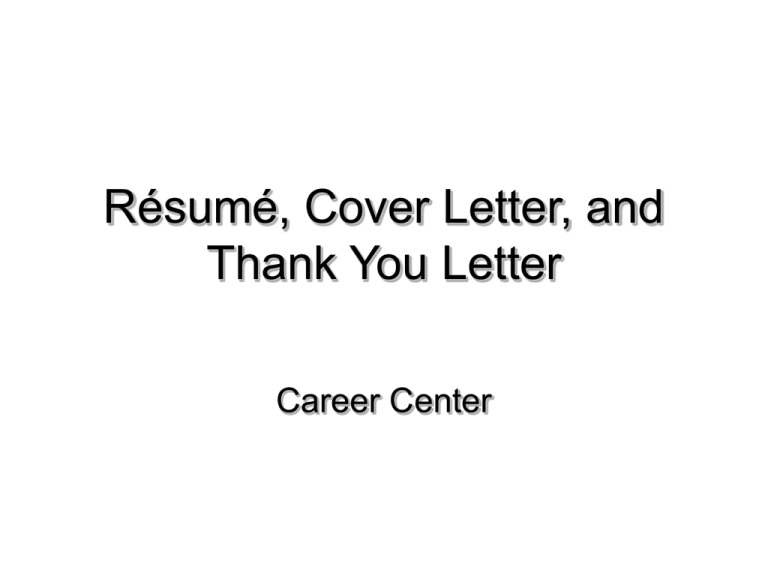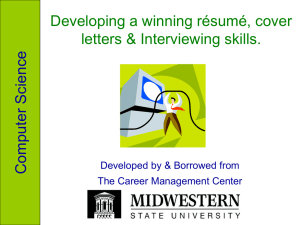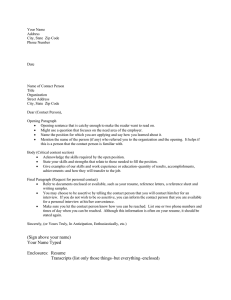Résumé, Cover Letter, and Thank You Letter Career Center
advertisement

Résumé, Cover Letter, and Thank You Letter Career Center Résumé RÉ-SU-MÉ rez-ə-mā n [F. resume fr. Pp. of resumer to resume, summarize] SUMMARY specif: a short account of one’s career and qualifications prepared typically by an applicant for a position. -Webster’s Résumé- General There is no one right way. A résumé is a persuasion paper not a laundry list. An Effective Résumé: - Shows a pattern of interest and experience - Makes a clear connection between qualifications and opportunity - Is readable and professional in presentation Functions of a Résumé Self-Inventory Extended Calling Card Agenda for an Interview Memory Jogger for the Employer After the Interview Résumé Writing Process Gather Information Write Rewrite Layout Revise Have it reviewed Edit again Résumé Outline Contact Information Objective Education Experience Activities/Honor/Service/Awards Kicker Heading The heading should include: -contact information, name, address, telephone number, and email address. *List both your campus and home addresses if it makes sense to do so (include validity dates). Heading Examples Objective The objective sets the course for the résumé. Everything listed on the résumé should support your objective. Career objective statements should avoid terms such as: Opportunity for advancement; a challenging position; position deal with people; a progressive company; position which requires creativity; a company that recognizes…; a chance to … While these terms may sound nice to the job applicant, they have little meaning to the person who will make a decision for an interview invitation, and in fact may indicate that the candidate has no idea about objectives. The candidate who applies vagueness will get a vague response in return. Objective Examples (job title) where there are opportunities to use (skills/knowledge) to (benefit to employer). Education The education section of your résumé typically follows the objective. The education section should include: -the name of the college or university, the level of degree you are working toward and an expected date of graduation, your major, and your minor, if you have one. In addition, you should include any projects relevant to the position. Include Study Abroad including in high school. Education Examples Completed Courses Include any completed courses if they are relevant to the position. This demonstrates the development of the appropriate skills. If you have limited work experience in the field, you can sell your education by writing a relevant course list including a section on academic projects you completed that are pertinent to the position for which you’re applying. Computer Skills Make sure to list computer skills listed in the job description if one is available. You don’t have to be an expert in using the software and hardware to list them on the resume. Pay particular attention to industry or job specific software. e.g. Adobe, SAS, etc. Honors Be selective about Honors and Activities. List those that may have importance to the hiring organization. You can include honors from other schools including high school. Experience Experience comes in many forms: -class projects -volunteer work -campus organizations -internships -part-time/full-time summer employment Action Words Describing Skills Accommodate Accomplish Achieve Act Adapt Administer Advertise Advise Advocate Affect Analyze Anticipate Apply Appraise Approach Arrange Assemble Assess Assign Assist Assume Attain Author Budget Build Calculate Catalogue Chair Clarify Collaborate Communicate Compare Conceive Conceptualize Conciliate Conduct Consult Control Cooperate Coordinate Counsel Create Decide Define Delegate Demonstrate Design Designate Detail Determine Develop Devise Direct Distribute Draft Edit Educate Encourage Enlarge Enlist Establish Estimate Evaluate Examine Exchange Execute Expand Expedite Facilitate Familiarize Forecast Formulate Fund-Raise Generate Govern Guide Handle Hire Identify Illustrate Implement Improve Index Influence Inform Initiate Innovate Inspect Install Institute Instruct Integrate Interpret Interview Investigate Invent Lead Listen Maintain Manage Manipulate Market Mediate Merchandise Moderate Modify Monitor Motivate Negotiate Obtain Operate Opportunity – Seeker Order Organize Originate Participate Perceive Perform Persuade Plan Present Preside ProblemSolve Process Produce Promote Propose Provide Publicize Publish React Recommend Reconcile Record Recruit Rectify Re-Design Relate More Action Words Renew Report Represent Research Resolve Review Revise Scan Schedule Screen Select Serve Solve Speak Staff Standardize Stimulate Summarize Supervise Survey Synthesize Teach Team-Build Train Transform Transmit Unify Update Utilize Write Marketing *creative *analytical *deal with ambiguity *conceptualize *coordinator/c ooperator Program oriented Advertiser Researcher Planner Promoter Leadership MIS *Systematic *Detail-oriented *Team leader *Futureoriented Technical Organized Analytical Conceptualize Problem-solver Integrate Implementer Patient R&D *creative *persistent *analytical *tolerance for Technical ambiguity Patient Focused Contemplative Scientific Tolerant Flexible Planning *long-term *visionary *detached *synthesizer Strategist Thinker Conceptualize Intangible GloballyOriented Creative Finance *analytical *conceptual *deal-maker *quantitative *decisive Project-oriented OpportunitySeeker Systematic ResourceAllocator Risk-Adjuster Administration/ General Management *implement *diplomatic *delegate *coordinator *political *talent scout Organized Motivator Detailed PowerOriented Behind-theScenes Manipulator Activities Be selective in order to keep your resume to one page. Include activities from both college and high school. List leadership activities. You can include travel. Activities can be listed in paragraph form with commas or in column form with or without bullets. Activities Examples References Note references are “Available upon request.” Be sure to print a copy of your resume for each of your references to ensure that they have complete information on your education and experience – which makes it easier for them to point out your strengths. TIPS PROOFREAD YOUR RESUME! Keep your resume to one page. It can be printed on 8½ x 11 copy paper. You can use color paper if desired, choose an offwhite or ivory color. If sending a paper copy, the resume can be folded. Be prepared to copy/paste into electronic templates on the organization’s website, include in the body of an email, or send as an attachment via email. Application Letter The purposes of this letter are to get your attached resume read and to generate interviews. Your strategy is to demonstrate that your qualifications fit the requirements of the position. Decide on one or more themes that show persuasively how well you fit the position: education, experience, interests, responsibility, etc. Link major job dimensions with your related past performance and experience. Sections of the Application Letter Addressing the Letter Opening Paragraph Education Paragraph Experience Paragraph Conclusion Addressing the Letter Address your letters to a specific individual with his or her correct title and business address. Opening Paragraph Come to the point. Reveal your purpose and interest. Identify the position and your source of information. Introduce your themes. Education Paragraph Refer reader to your resume. Outline your strongest qualifications that match the position requirements based on the themes you selected. Experience Paragraph Provide evidence of your related experiences and accomplishments. Make reference to your enclosed resume. Concluding Paragraph Suggest an action plan. Request an interview, and indicate that you will call during a specific time period to discuss interview possibilities. Express appreciation to the reader for his or her time and consideration. Thank You Letter This is one of the most important yet least used tools in a job search. It is used to establish goodwill, express appreciation, and/or strengthen your candidacy. Make your thank-you letters warm and personal. Thank You Letter should be sent within 72 hours of your contact. Thank You Letter Format Opening Paragraph: Express your sincere appreciation. Body Paragraph: Reemphasize your strongest qualifications. Draw attention to the good match between your qualifications and job requirements. Concluding Paragraph: Reiterate your interest in the position. Use the opportunity to provide or offer supplemental information not previously given. Restate your appreciation. Thank You Letter Example Thank You for Participating! Career Center 201 Behmler Hall 589-6065 http://www.morris.umn.edu/services/career/

